Marigolds are easy-to-grow annuals for which even beginner gardeners can succeed. The bright gold and copper flowers of marigolds are a welcome reward for beginning gardeners’ hard work. As a result of its capacity to bloom continuously throughout the summer, this flower has become a favorite choice for gardeners and pollinators. You can enjoy these benefits with minimal work if you have a garden. Let’s check out how to grow marigolds at home in the USA.
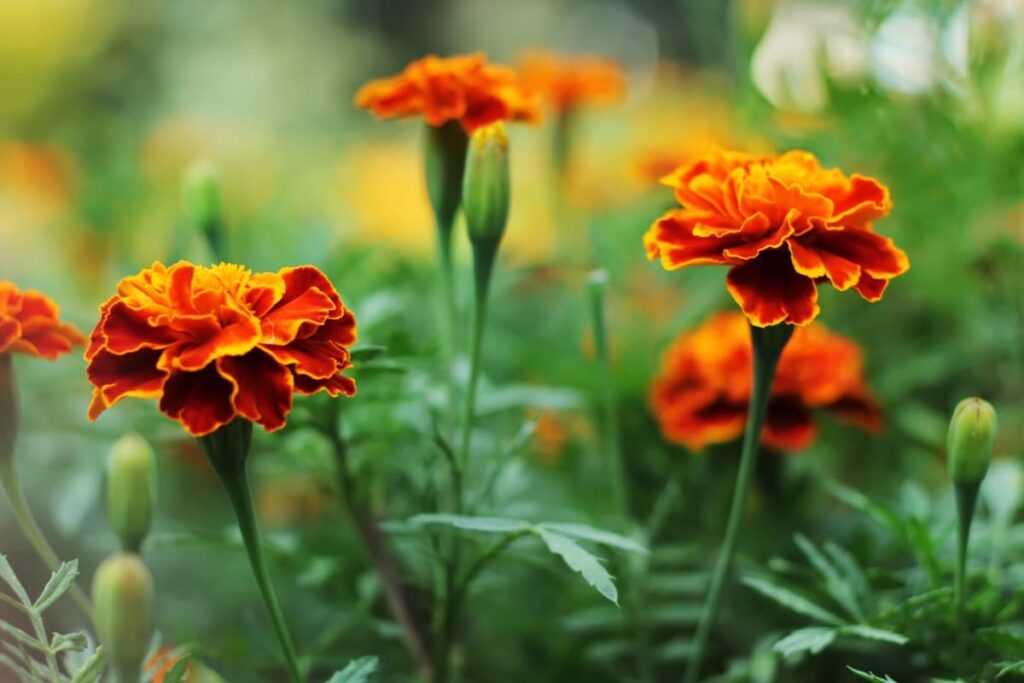
It doesn’t matter whether you sow marigold seeds inside or outside; they’re simple to grow and need little to no attention. Growing marigolds in the USA is easy by following the steps and procedures below. However, many Indians in the USA might be wondering how to grow marigold plants at home in pots, backyard, and indoors. This article will help you grow marigolds at home in the USA from seeds, cuttings, and possible ways.
How to Grow Marigold at Home in the USA
Where to Grow Marigold plants?
Zones 2–11 of the US Department of Agriculture’s plant hardiness map include marigolds, although they only bloom during the spring and summer. In USDA zones eight and lower, marigolds have a shorter lifetime when temperatures dip below freezing early in the Season.
Conversely, a colder winter has a more extended flowering season for marigolds grown in USDA zones ten and above. Marigolds will bloom for 45 to 60 days after they are planted after the final spring frost, and they will continue to flower until the first autumn frost. Deadheading marigolds isn’t strictly necessary, but removing spent flowers encourages the plants to bloom more heavily.
How to Grow Marigolds from Seeds?
Marigolds can be grown from seed quite quickly. Marigold seeds can be started indoors approximately 7 to 8 weeks before your last frost, but they sprout fast when placed directly into the garden soil. You may not need to plant any new marigolds this year since the ones from last year’s crop tend to self-seed. Sow marigold seeds on the surface of a tray or tiny pots filled with standard commercial potting soil, gently wet if you choose to start them inside. Add vermiculite to the tray or pot, and then cover it with a plastic sheet.
Place the container somewhere warm but without direct light until the seeds have germinated and sprouted. Relocate the container to a place with four to five hours of bright light each day after the seeds have sprouted. Make sure the potting soil is well-hydrated but not soggy. Avoid damping-off fungal infection by watering from the bottom up, enabling trays or pots to soak up water from the bottom of a tray. Then, after all the risk of frost has gone, seedlings can be transplanted outside as soon as they begin vigorously growing new leaves.
In case you missed it: Zone 9 Gardening Guide for Vegetables, Flowers, Fruits, Herbs, and Month-by-Month Calendar
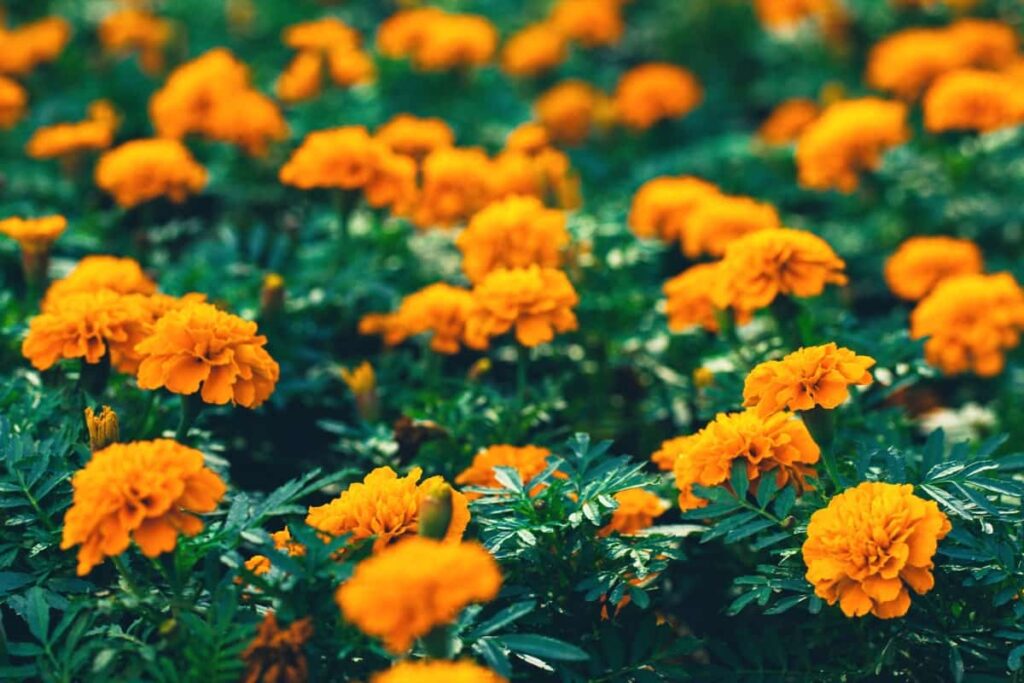
How to Grow Marigolds from Cuttings?
To grow marigolds at home in the USA, most gardeners propagate marigolds by starting them from seed because they are quick and straightforward. You can save seeds for the next year by deadheading your flowers while wilting. Cuttings can also be used to propagate marigolds. Clean, sharp garden scissors are needed to cut stems 2 to 6 inches long. Each one should have three pairs of leaves but no flowers. Ensure you only leave the top row of leaves.
The cuttings are inserted one at a time into the well-drained soilless potting mix, which has been moistened, using a screwdriver or stick. The end can be dipped in rooting hormone if desired. Place the tray in a plastic bag, ensuring the bag does not contact the leaves. Relocate the tray arrangement in a warm, bright environment with indirect light. Keep the soil moist with water. The roots will take just a few weeks to form. Then, it’s time to move each rooted cutting into its pot.
How to Grow Marigolds in Pots?
Choose an Ideal Container
This is dependent on the kind of plant you’re cultivating. French, Signet, and Pot Marigolds can be grown in 6-8 inch pots. Consider a pot of 10-12 inches for more significant types like African Marigolds. Stick to the “one plant per pot” rule if you have a tiny pot. Potting soil of high grade should be used to fill a container within one inch of the rim.
In case you missed it: How to Create Productive Flower Garden: A Complete Guide for Beginners
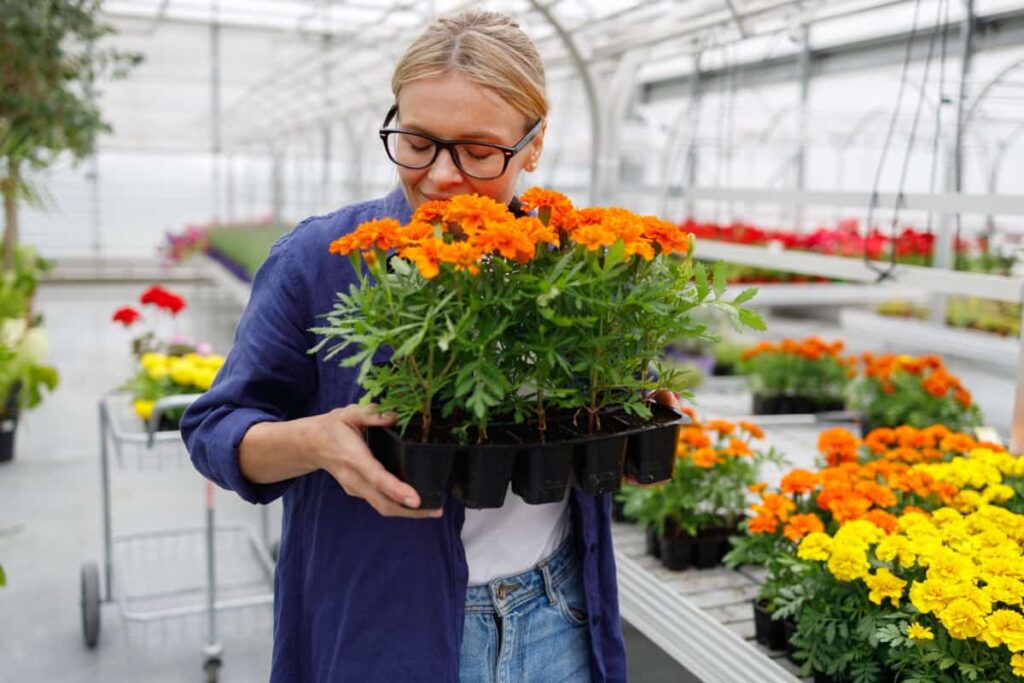
With a drainage hole at the bottom, marigolds can be grown in any sturdy container. Regular garden soil will compact in your container, preventing water from reaching the roots of your marigolds. In addition to germs, insects, and weed seeds, garden soil can include other unwanted things.
How to Plant Marigold Seeds in Pots?
At a garden shop or greenhouse, buy marigold bedding plants. Marigolds come in various sizes and colors and can be grown in containers. It’s time to remove each marigold one by one from its container. To plant a marigold, you first need to dig a tiny hole with a trowel and then insert it into it. Next, gently press the potting soil into the roots.
On pots, marigolds may be planted closer together than in the ground, allowing for a more compact appearance. Marigolds of smaller types should be spaced 3 inches apart, while large marigolds may be 5 inches apart. Marigolds need at least six to eight hours of direct sunshine daily to thrive.
Watering Marigolds in Pots
Once you’ve planted your marigolds, water them regularly until new growth appears. As a result, marigolds are drought-resistant plants, although they still need some watering during the year’s hottest months. First, deeply water the plants, letting water flow freely down the drainage hole, and then water once more until the soil feels reasonably dry.
Marigold Fertilizer Requirements in Pots
Marigolds planted in containers need fertilizer since they cannot absorb nutrients from the soil. Feed marigolds once a week with a water-soluble fertilizer prepared according to the package’s instructions. For weekly feedings, dilute the solution by one-fourth if the package directions suggest a monthly feeding. Then, apply a timed-release fertilizer to the instructions on the box.
How to Plant Marigolds in the Backyard?
Soil Requirements for Marigolds in the Backyard
Marigolds have a few requirements. They’ll be happy in garden soil if it is not too acidic. It is best to keep the soil pH at 6.0 to 7.0. There is no requirement for soil that is especially rich in organic matter for them to thrive.
How to Plant Marigold Seeds in the Backyard of your Home?
When starting from seed, marigolds germinate fast, sprouting in only a few days and flowering in eight weeks. When the earth has warmed enough, and the threat of frost has gone, go direct-sow seeds outdoors. After sowing, water the seeds well. Thinning is necessary once the seeds have sprouted.
In case you missed it: Drip Fertigation in Flower Crops: A Practical Guide for Floriculture Farmers
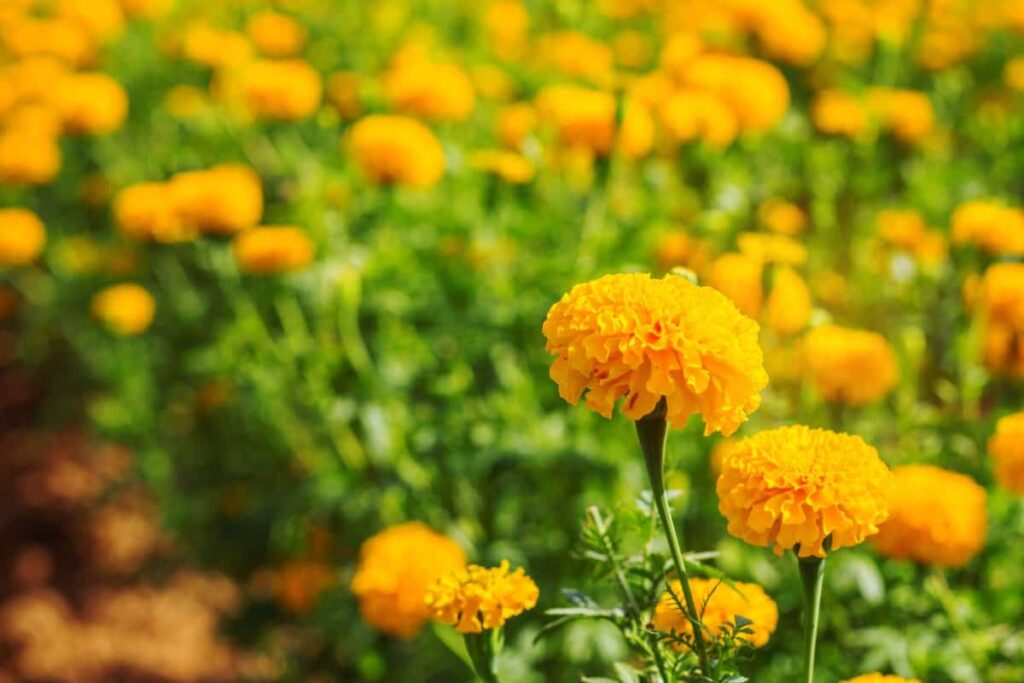
Garden scissors or tiny garden shears should be used to remove the seedlings since pulling them out might damage the roots of the remaining seedlings. Although seeds can be planted inside early, this is optional due to their short germination period. When seedlings are 2 inches tall, they can be replanted.
Watering Requirements for Marigolds in the Backyard
To grow marigolds at home in the US, ensure your marigold seeds or seedlings receive frequent watering when you initially plant them. Keep them out of dry soil for no more than a few days. New plants should be watered daily if the weather is hot and sunny. Drought tolerance will increase after a few weeks of root development, but weekly watering will still provide the best flowers.
Temperature and Humidity Requirements for Marigolds
Summers are the best time to cultivate marigolds, which flourish in zones 2 to 11. Even in the US warmer climates, the blooming of these true annuals comes back up when the temperature cools down later in the summer and into the autumn. Marigolds can endure a broad humidity range but can develop powdery mildew in humid or moist summers in the USA. This difficulty can be solved by planting in full sun and leaving enough space for air circulation. Native to Mexico, these plants thrive in drier conditions.
Marigold Fertilizer Requirements in the Backyard
Unless your soil is really poor, you should only need to add fertilizer to your marigolds’ soil. Deadheading is the greatest way to keep your flowers blooming.
Pests and Diseases in Marigold
Spider mites and aphids can occasionally infest marigolds, although the plants are generally free of pests. A water spray or insecticide will be needed if the problem remains for over a week or two. If the weather is excessively moist, marigolds might suffer from fungal diseases like powdery mildew. Minimize watering the marigolds’ leaves, control weeds, and plant in well-drained soil to avoid fungal problems.
How to Grow Marigold Faster?
Marigolds germinate fast, sprouting in a few days and flowering in around eight weeks, making them simple to grow from seed. Sow seeds outside as soon as the threat of frost has gone. After planting, space seeds 1 inch apart and water them well. The next step is to thin the germinated seeds. Taking care of these things can make your marigold plant grow faster.
In case you missed it: Easy Homemade Fertilizer Recipes: Natural and Organic for Houseplants, Flowers, and Garden Plants
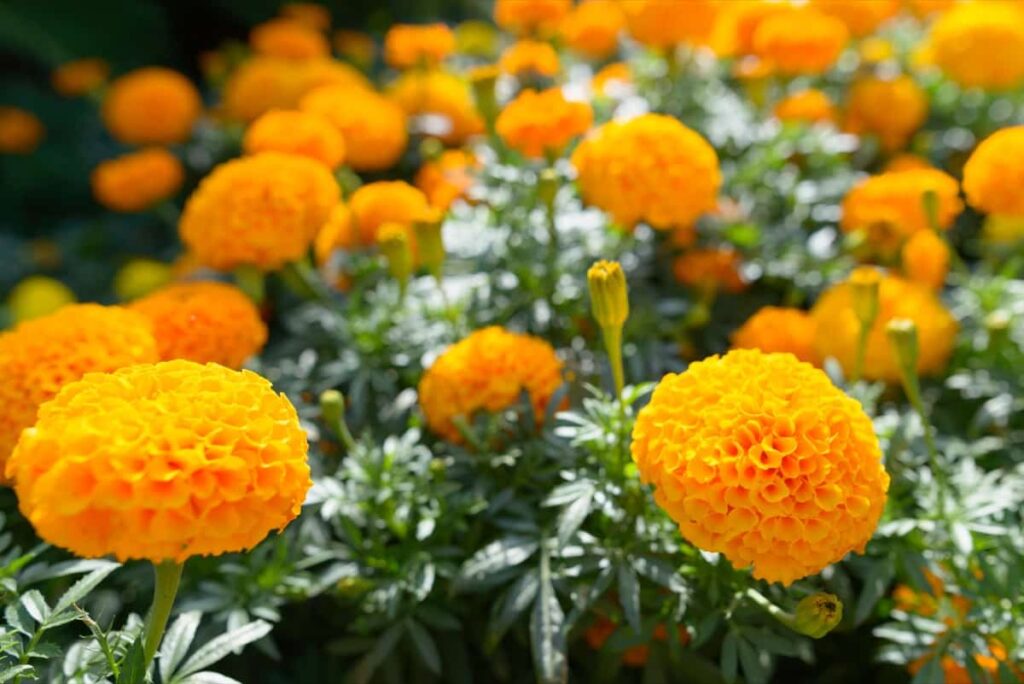
How to Deadhead the Marigolds?
You pinch off the flower’s top and remove any fading flowers to do deadheading. Rather than spending energy on seed formation, pinching off the dead flower heads of certain plants, like marigolds, might stimulate the plant to produce new blooms and prolong the blooming Season. Deadheading enhances the appearance of marigolds, too. The process couldn’t be simpler when it comes to cutting back marigolds. Whenever a flower begins to deteriorate, pinch its stalk back to the next set of leaves.
Overwintering for Marigolds
A true annual marigold is ready to be removed when the winter weather eventually takes its toll. However, leaving a few plants to self-seed in the garden is OK. Birds will not consume the marigold seeds most of the time, but they have been known to break apart flowers, which helps the seeds germinate and spread.
In case you missed it: Terrace Gardening ideas for Home in India: For Vegetables, Fruits, Flowers, and Herbs

How do Marigolds Grow from Dried Flowers?
- Marigolds can be grown from dried flowers by simply waiting for the flowers to fade. Then, shear them when they’re dry and a light brown color.
- After removing the dried petals, place a paper towel on a flat surface and crush the flower. There will be a seed drop. They have a thin, light-colored form and are small in size.
- Opt for a location with 6 to 7 hours of direct sunshine daily. It’s best to use well-rotted compost or manure in a medium-sized pot. After pushing the seeds into the earth, cover them with soil. They will begin to grow in 2 to 5 weeks.
What to do with Marigolds at the end of the Season?
- End-of-season marigold care ensures it receives the most daylight possible before winter. Seeds will be able to grow more quickly if the plant can take in and store a lot of energy. It will also retain its color for a more extended period in this manner.
- Making sure the marigold has adequate water is the next stage. Allow the soil to get soaked and penetrated by the water. Water your plants twice weekly now that they’re in their peak blooming Season.
- Next, you have to add a few inches of mulch to the marigolds’ soil, but only do it a little, especially don’t mulch around the main stem; the soil near the main stem should be exposed.
- Finally, remove any wilting flowers or damaged plant sections to encourage new development in the last step. The newer growth occurs in the months before winter, the better it is.
When do Marigold Blooms?
Full light and well-draining soil are needed to keep them blooming for the whole Season. When planted, marigold seeds germinate fast and bloom in approximately eight weeks. As a result, they’re a terrific first-time gardening project for children and others new to the hobby.
In case you missed it: Top 4 Jasmine Flowering Plants for Fragrance: How to Grow, Care, and Make Bushy for More Blooms
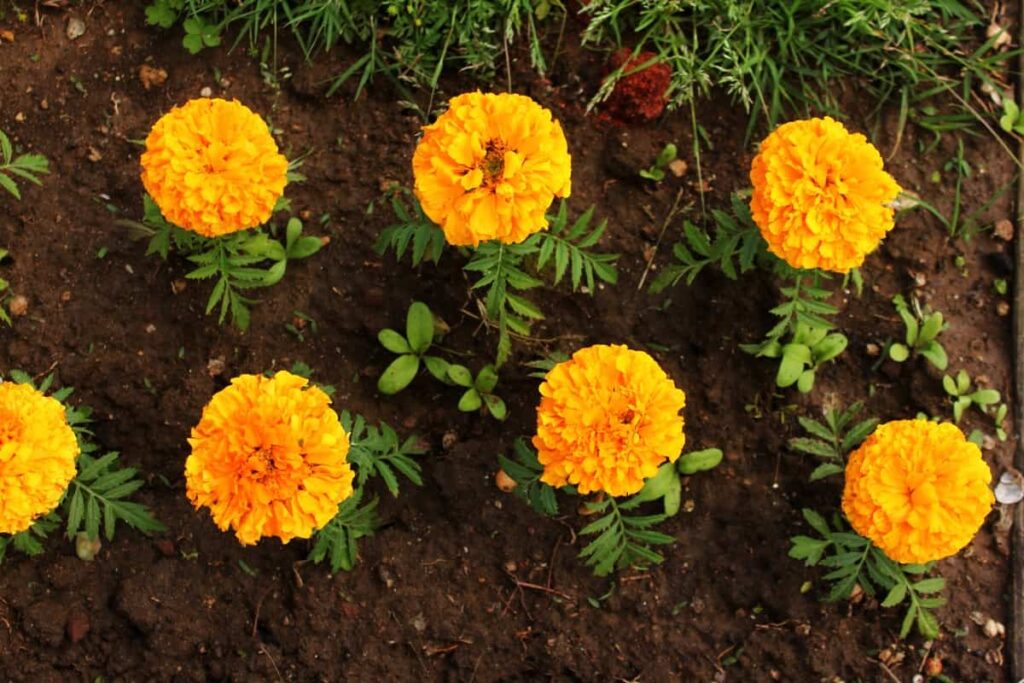
Conclusion
Growing Marigolds from seeds is easy, and you will enjoy the flowers in your home garden. If you are living in the following states of the USA and plan to grow marigolds, this blog post will help you understand the basics of growing from seed.
| Alabama | Iowa |
| Arizona | Kansas |
| Arkansas | Kentucky |
| California | Louisiana |
| Colorado | Maine |
| Connecticut | Maryland |
| Delaware | Massachusetts |
| Florida | Michigan |
| Georgia | Minnesota |
| Idaho | Mississippi |
| Illinois | Missouri |
| Indiana | Montana |
| Nebraska | Rhode Island |
| Nevada | South Carolina |
| New Hampshire | South Dakota |
| New Jersey | Tennessee |
| New Mexico | Texas |
| New York | Utah |
| North Carolina | Vermont |
| North Dakota | Virginia |
| Ohio | Washington |
| Oklahoma | West Virginia |
| Oregon | Wisconsin |
| Pennsylvania | Wyoming |
- Management Pests and Diseases in Your Cotton Field
- Sheep Farming Business Plan for Beginners
- Aquaponic Farming at Home: A Step-By-Step Guide
- Profitable Village Farming Business Ideas in 2024
- High-Yield Aquaculture: Fast-Growing Fish for Farming
- Effective Fish Pond Construction Techniques for Beginners
- Irrigation and Water Management in Pineapple Farming
- Blossom to Harvest: Mastering Flowering and Pollination in Papaya Farming
- Pig Fattening Essentials: From Selection to Sale for Beginners
- Raising Wagyu Cattle: A Complete Guide for Premium Beef Production
- Soil Types and Their Water Holding Capacity
- Optimizing Irrigation Schedules for Coconut Groves for Enhanced Yield
- Espresso Your Garden: Coffee Grounds for Healthier Acid-Loving Plants
- The Best Soil Mix for Snake Plants: How to Mix Your Own Snake Plant Soil
- Green Thumb Success: Expert Tips for Cultivating Greenhouse Beans All Year Round
- Bloom All Year Round: The Ultimate Guide to Indoor Hyacinth Care
- Eco-Friendly Gardening: How to Make Liquid Fertilizer from Kitchen Waste
- Ultimate Guide to Grow Anise in Pots: Explore Seed Propagation to Harvesting
- Guide to Raising Chester White Pigs: Discover Breed Facts to Growth Management
- Mastering the Elegance: The Ultimate Guide to Weeping Cherry Tree Care, Planting, and Maintenance
- Ultimate Guide to Planting Garlic in Grow Bags: Growing Strategies for Beginners
- How to Fix Spider Plant Leaf-Related Problems: Natural and Organic Remedies
- 10 Reasons Why Your Tulsi Plant is Shedding Leaves: Home Remedies and Solutions
- Optimizing Growth and Yield: The Advantages of Palm Bunch Ash Fertilizer
- Utilizing Neem Oil Extract as a Natural Pesticide for Hydrangea
- From Soil to Harvest: Various Ways in Which Farmers Can Use AI Tools
- Steps to Encourage and Induce Citrus Flowers: A Comprehensive Guide
- How to Fix Snake Plant Leaf-Related Issues: Natural and Organic Remedies
- Transform Your Garden into a Fragrant Oasis with Raat Ki Rani (Night Blooming Jasmine)
- Discover the Ideal Chicken Breeds for Philippine Farms
- How to Create a Poultry Egg Farm Business Plan for Profits
- Grow Lemon Cucumbers Like a Pro: Insider Techniques for Bountiful Yields
- Ultimate Guide to Caring for Your Pink Princess Philodendron: Tips for Thriving Variegation
- Areca Nut Profit Per Acre: Calculating Yield and Cost of Cultivation
- How Kaveri Chicken is Becoming a More Profitable Breed in Indian Backyards
- Transform Your Barn: 9 Steps to Convert a Horse Stall into a Chicken Coop
